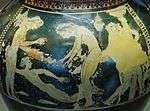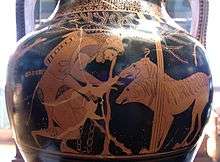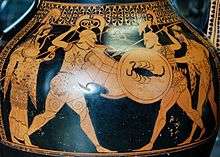Andokides painter
The Andokides painter was an ancient Athenian vase painter who was active from 530 to approximately 515 BCE.[1] His work is unsigned; he is named after Andokides, the potter for whom he worked. He is believed to be the inventor of the red figure style of vase painting.
Beginnings of his art

Andokides began working at a time when the black-figure style predominated. He was undoubtedly a student of Exekias, one of the masters of the art. The technical limits of this black-figure technique, which required the incision of detail onto a silhouette of a figure, were reached around the late 6th century BCE. The Andokides painter undertook brief tests, brushing white paint directly on a glazed black base. The white wash was fragile, as seen on an amphora preserved in the Louvre (inv.F203) which is ascribed to him. He next had the idea to reverse the process: he reserved the background in black glaze instead of the foreground figures. In this way, the red color of the clay became the ground on to which further details of the characters were painted in black with a fine brush. This method allowed greater precision and more detail than before.
The first evidence of the new technique—that would gradually spread to dominate the art—dates to 530 BCE. During a transitional period, the Andokides painter produced amphoras which present the black figure style on one side and the red figure style on the other, sometimes with the same scene. These vases may have been tests to present the new technique to his customers. These vases are called bilingual. Thereafter, he produced only vases in the red figure style.
He was not the only one to use these innovations. Others, like Oltos or Epiktetos, produced bilingual vases, but the majority of researchers agree that the works of the Andokides painter were produced a few years before the others, which means he was likely the principal inventor of the technique.
Painting style
A score of vases with black figures, whose attribution is disputed by some researchers, show that the Andokides painter gradually attained greater control and virtuosity in the technique. Earlier examples appear a little stiff. Later, the artist exploits the benefits inherent in the technique, utilizing a range of colors from red to dark brown. The Andokides painter marked the arrival of the red figure style that was later used by great artists like Euphronios. The painter's most favored subject matter was a wide range of mythological scenes depicting the gods and heroes. Heracles was his favorite character.
Works
| Name | Images | Dimensions | Type | Date | Description | Museum Record | |
| Berlin, Antikensammlung | |||||||
| F 2159 | H. 58.2 cm. | Belly Amphora | c. 525 BC | Herakles and the Delphic Tripod; Wrestlers | Perseus | ||
| Bologna, Museo Civico | |||||||
| --- | Amphora | A: Herakles and the Nemean Lion B: Dionysos | |||||
| London, British Museum | |||||||
| B 193 | H. 54.6 cm | Belly Amphora | c. 520 BC | A: Achilles and Ajax B: Herakles and Nemean Lion | Record | ||
| Munich, Staatliche Antikensammlungen | |||||||
| 2301 |  |  | H. 53.5 cm D. 22.5 cm | Belly Amphora | 520-510 BC | A: Herakles feasting B: Herakles feasting | |
| Paris, Louvre | |||||||
| F 203 |  | H: 40.5 cm D: 25.2 cm | Amphora | 530-520 BC | A: Amazons; B: Bathing women | Perseus | |
| F 204 |  | H. 58.20 cm; D. 37.50 cm | Amphora | 530-520 BC | A: Herakles and Kerberos | ||
| G1 |  | H. 57.2 cm; D. 36.6 cm | Amphora | 525-520 BC | A: Hoplite battle; B: Citharode | Perseus | |
References
- ↑ Boardman, J. Athenian Red Figure Vases: The Archaic Period. London: Thames and Hudson, 1975. p. 15.
| Wikimedia Commons has media related to Andokides Painter. |
- John Beazley. Attic Black-figure Vase-Painters. Oxford: Clarendon Press, 1956.
- Boardman, J. Athenian Black Figure Vases: A Handbook. London: Thames and Hudson, 1974.
- Williams, D. (1985). Greek Vases. London: British Museum Press, 1999.
- Tansey, R. and F. Kleiner. 1996: Gardner's Art Through the Ages - 10th Edition, USA: Harcourt Brace College, 136-137.